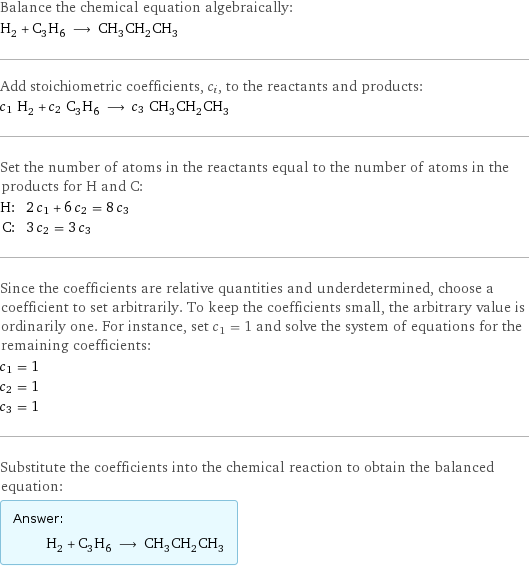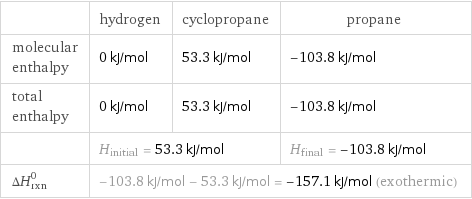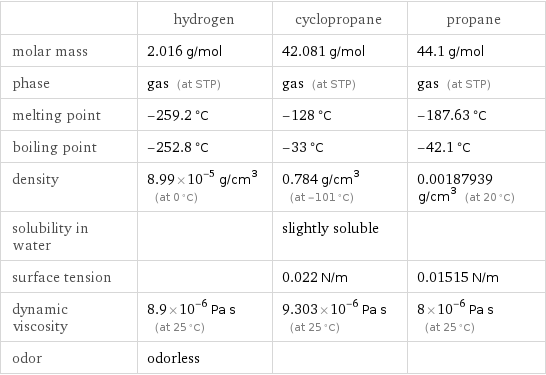Input interpretation

H_2 hydrogen + C_3H_6 cyclopropane ⟶ CH_3CH_2CH_3 propane
Balanced equation

Balance the chemical equation algebraically: H_2 + C_3H_6 ⟶ CH_3CH_2CH_3 Add stoichiometric coefficients, c_i, to the reactants and products: c_1 H_2 + c_2 C_3H_6 ⟶ c_3 CH_3CH_2CH_3 Set the number of atoms in the reactants equal to the number of atoms in the products for H and C: H: | 2 c_1 + 6 c_2 = 8 c_3 C: | 3 c_2 = 3 c_3 Since the coefficients are relative quantities and underdetermined, choose a coefficient to set arbitrarily. To keep the coefficients small, the arbitrary value is ordinarily one. For instance, set c_1 = 1 and solve the system of equations for the remaining coefficients: c_1 = 1 c_2 = 1 c_3 = 1 Substitute the coefficients into the chemical reaction to obtain the balanced equation: Answer: | | H_2 + C_3H_6 ⟶ CH_3CH_2CH_3
Structures

+ ⟶
Names

hydrogen + cyclopropane ⟶ propane
Reaction thermodynamics
Enthalpy

| hydrogen | cyclopropane | propane molecular enthalpy | 0 kJ/mol | 53.3 kJ/mol | -103.8 kJ/mol total enthalpy | 0 kJ/mol | 53.3 kJ/mol | -103.8 kJ/mol | H_initial = 53.3 kJ/mol | | H_final = -103.8 kJ/mol ΔH_rxn^0 | -103.8 kJ/mol - 53.3 kJ/mol = -157.1 kJ/mol (exothermic) | |
Gibbs free energy

| hydrogen | cyclopropane | propane molecular free energy | 0 kJ/mol | 104.5 kJ/mol | -23.4 kJ/mol total free energy | 0 kJ/mol | 104.5 kJ/mol | -23.4 kJ/mol | G_initial = 104.5 kJ/mol | | G_final = -23.4 kJ/mol ΔG_rxn^0 | -23.4 kJ/mol - 104.5 kJ/mol = -127.9 kJ/mol (exergonic) | |
Entropy

| hydrogen | cyclopropane | propane molecular entropy | 115 J/(mol K) | 266.9 J/(mol K) | 270 J/(mol K) total entropy | 115 J/(mol K) | 266.9 J/(mol K) | 270 J/(mol K) | S_initial = 381.9 J/(mol K) | | S_final = 270 J/(mol K) ΔS_rxn^0 | 270 J/(mol K) - 381.9 J/(mol K) = -111.9 J/(mol K) (exoentropic) | |
Equilibrium constant
![Construct the equilibrium constant, K, expression for: H_2 + C_3H_6 ⟶ CH_3CH_2CH_3 Plan: • Balance the chemical equation. • Determine the stoichiometric numbers. • Assemble the activity expression for each chemical species. • Use the activity expressions to build the equilibrium constant expression. Write the balanced chemical equation: H_2 + C_3H_6 ⟶ CH_3CH_2CH_3 Assign stoichiometric numbers, ν_i, using the stoichiometric coefficients, c_i, from the balanced chemical equation in the following manner: ν_i = -c_i for reactants and ν_i = c_i for products: chemical species | c_i | ν_i H_2 | 1 | -1 C_3H_6 | 1 | -1 CH_3CH_2CH_3 | 1 | 1 Assemble the activity expressions accounting for the state of matter and ν_i: chemical species | c_i | ν_i | activity expression H_2 | 1 | -1 | ([H2])^(-1) C_3H_6 | 1 | -1 | ([C3H6])^(-1) CH_3CH_2CH_3 | 1 | 1 | [CH3CH2CH3] The equilibrium constant symbol in the concentration basis is: K_c Mulitply the activity expressions to arrive at the K_c expression: Answer: | | K_c = ([H2])^(-1) ([C3H6])^(-1) [CH3CH2CH3] = ([CH3CH2CH3])/([H2] [C3H6])](../image_source/c713cb410af078d59e8c8098784b0139.png)
Construct the equilibrium constant, K, expression for: H_2 + C_3H_6 ⟶ CH_3CH_2CH_3 Plan: • Balance the chemical equation. • Determine the stoichiometric numbers. • Assemble the activity expression for each chemical species. • Use the activity expressions to build the equilibrium constant expression. Write the balanced chemical equation: H_2 + C_3H_6 ⟶ CH_3CH_2CH_3 Assign stoichiometric numbers, ν_i, using the stoichiometric coefficients, c_i, from the balanced chemical equation in the following manner: ν_i = -c_i for reactants and ν_i = c_i for products: chemical species | c_i | ν_i H_2 | 1 | -1 C_3H_6 | 1 | -1 CH_3CH_2CH_3 | 1 | 1 Assemble the activity expressions accounting for the state of matter and ν_i: chemical species | c_i | ν_i | activity expression H_2 | 1 | -1 | ([H2])^(-1) C_3H_6 | 1 | -1 | ([C3H6])^(-1) CH_3CH_2CH_3 | 1 | 1 | [CH3CH2CH3] The equilibrium constant symbol in the concentration basis is: K_c Mulitply the activity expressions to arrive at the K_c expression: Answer: | | K_c = ([H2])^(-1) ([C3H6])^(-1) [CH3CH2CH3] = ([CH3CH2CH3])/([H2] [C3H6])
Rate of reaction
![Construct the rate of reaction expression for: H_2 + C_3H_6 ⟶ CH_3CH_2CH_3 Plan: • Balance the chemical equation. • Determine the stoichiometric numbers. • Assemble the rate term for each chemical species. • Write the rate of reaction expression. Write the balanced chemical equation: H_2 + C_3H_6 ⟶ CH_3CH_2CH_3 Assign stoichiometric numbers, ν_i, using the stoichiometric coefficients, c_i, from the balanced chemical equation in the following manner: ν_i = -c_i for reactants and ν_i = c_i for products: chemical species | c_i | ν_i H_2 | 1 | -1 C_3H_6 | 1 | -1 CH_3CH_2CH_3 | 1 | 1 The rate term for each chemical species, B_i, is 1/ν_i(Δ[B_i])/(Δt) where [B_i] is the amount concentration and t is time: chemical species | c_i | ν_i | rate term H_2 | 1 | -1 | -(Δ[H2])/(Δt) C_3H_6 | 1 | -1 | -(Δ[C3H6])/(Δt) CH_3CH_2CH_3 | 1 | 1 | (Δ[CH3CH2CH3])/(Δt) (for infinitesimal rate of change, replace Δ with d) Set the rate terms equal to each other to arrive at the rate expression: Answer: | | rate = -(Δ[H2])/(Δt) = -(Δ[C3H6])/(Δt) = (Δ[CH3CH2CH3])/(Δt) (assuming constant volume and no accumulation of intermediates or side products)](../image_source/25f342cb619dafaf87e85cfc804491f7.png)
Construct the rate of reaction expression for: H_2 + C_3H_6 ⟶ CH_3CH_2CH_3 Plan: • Balance the chemical equation. • Determine the stoichiometric numbers. • Assemble the rate term for each chemical species. • Write the rate of reaction expression. Write the balanced chemical equation: H_2 + C_3H_6 ⟶ CH_3CH_2CH_3 Assign stoichiometric numbers, ν_i, using the stoichiometric coefficients, c_i, from the balanced chemical equation in the following manner: ν_i = -c_i for reactants and ν_i = c_i for products: chemical species | c_i | ν_i H_2 | 1 | -1 C_3H_6 | 1 | -1 CH_3CH_2CH_3 | 1 | 1 The rate term for each chemical species, B_i, is 1/ν_i(Δ[B_i])/(Δt) where [B_i] is the amount concentration and t is time: chemical species | c_i | ν_i | rate term H_2 | 1 | -1 | -(Δ[H2])/(Δt) C_3H_6 | 1 | -1 | -(Δ[C3H6])/(Δt) CH_3CH_2CH_3 | 1 | 1 | (Δ[CH3CH2CH3])/(Δt) (for infinitesimal rate of change, replace Δ with d) Set the rate terms equal to each other to arrive at the rate expression: Answer: | | rate = -(Δ[H2])/(Δt) = -(Δ[C3H6])/(Δt) = (Δ[CH3CH2CH3])/(Δt) (assuming constant volume and no accumulation of intermediates or side products)
Chemical names and formulas

| hydrogen | cyclopropane | propane formula | H_2 | C_3H_6 | CH_3CH_2CH_3 Hill formula | H_2 | C_3H_6 | C_3H_8 name | hydrogen | cyclopropane | propane IUPAC name | molecular hydrogen | cyclopropane | propane
Substance properties

| hydrogen | cyclopropane | propane molar mass | 2.016 g/mol | 42.081 g/mol | 44.1 g/mol phase | gas (at STP) | gas (at STP) | gas (at STP) melting point | -259.2 °C | -128 °C | -187.63 °C boiling point | -252.8 °C | -33 °C | -42.1 °C density | 8.99×10^-5 g/cm^3 (at 0 °C) | 0.784 g/cm^3 (at -101 °C) | 0.00187939 g/cm^3 (at 20 °C) solubility in water | | slightly soluble | surface tension | | 0.022 N/m | 0.01515 N/m dynamic viscosity | 8.9×10^-6 Pa s (at 25 °C) | 9.303×10^-6 Pa s (at 25 °C) | 8×10^-6 Pa s (at 25 °C) odor | odorless | |
Units
